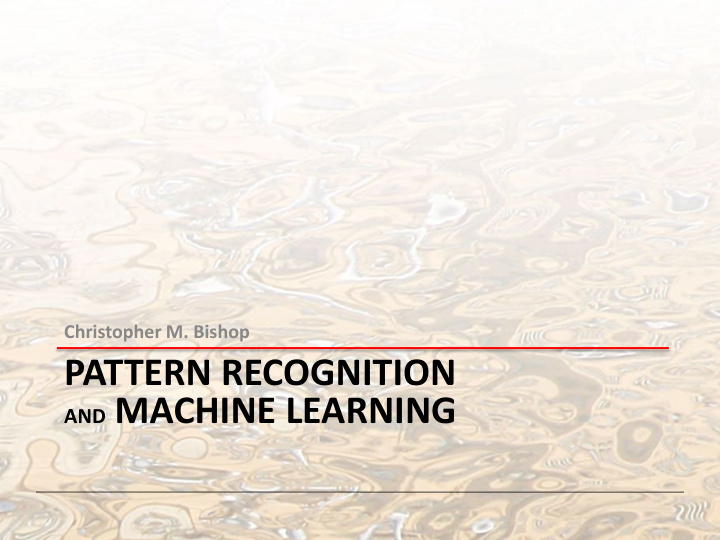



Christopher M. Bishop PATTERN RECOGNITION AND MACHINE LEARNING
Polynomial Curve Fitting
Sum-of-Squares Error Function
0 th Order Polynomial
1 st Order Polynomial
3 rd Order Polynomial
9 th Order Polynomial
Over-fitting Root-Mean-Square (RMS) Error:
Polynomial Coefficients
Data Set Size: 9 th Order Polynomial
Data Set Size: 9 th Order Polynomial
Regularization Penalize large coefficient values
Regularization:
Regularization:
Regularization: vs.
Polynomial Coefficients
The Gaussian Distribution
Gaussian Parameter Estimation Likelihood function
Maximum (Log) Likelihood
Properties of and
Curve Fitting Re-visited
Maximum Likelihood Determine by minimizing sum-of-squares error, .
Predictive Distribution
MAP: A Step towards Bayes Determine by minimizing regularized sum-of-squares error, .
Bayesian Curve Fitting
Bayesian Predictive Distribution
Model Selection Cross-Validation
Parametric Distributions Basic building blocks: Need to determine given Representation: or ? Recall Curve Fitting
Binary Variables (1) Coin flipping: heads=1, tails=0 Bernoulli Distribution
Binary Variables (2) N coin flips: Binomial Distribution
Binomial Distribution
Parameter Estimation (1) ML for Bernoulli Given:
Parameter Estimation (2) Example: Prediction: all future tosses will land heads up Overfitting to D
Beta Distribution Distribution over .
Bayesian Bernoulli The Beta distribution provides the conjugate prior for the Bernoulli distribution.
Beta Distribution
Prior ∙ Likelihood = Posterior
Properties of the Posterior As the size of the data set, N , increase
Prediction under the Posterior What is the probability that the next coin toss will land heads up?
Multinomial Variables 1 -of- K coding scheme:
ML Parameter estimation Given: Ensure , use a Lagrange multiplier, ¸ .
The Multinomial Distribution
The Dirichlet Distribution Conjugate prior for the multinomial distribution.
Bayesian Multinomial (1)
Bayesian Multinomial (2)
The Gaussian Distribution
Maximum Likelihood for the Gaussian (1) Given i.i.d. data , the log likeli- hood function is given by Sufficient statistics
Maximum Likelihood for the Gaussian (2) Set the derivative of the log likelihood function to zero, and solve to obtain Similarly
Maximum Likelihood for the Gaussian (3) Under the true distribution Hence define
Bayesian Inference for the Gaussian (1) Assume ¾ 2 is known. Given i.i.d. data , the likelihood function for ¹ is given by This has a Gaussian shape as a function of ¹ (but it is not a distribution over ¹ ).
Bayesian Inference for the Gaussian (2) Combined with a Gaussian prior over ¹ , this gives the posterior Completing the square over ¹ , we see that
Bayesian Inference for the Gaussian (3) … where Note:
Bayesian Inference for the Gaussian (4) Example: for N = 0, 1, 2 and 10.
Bayesian Inference for the Gaussian (5) Sequential Estimation The posterior obtained after observing N { 1 data points becomes the prior when we observe the N th data point.
Bayesian Inference for the Gaussian (6) Now assume ¹ is known. The likelihood function for ¸ = 1/ ¾ 2 is given by This has a Gamma shape as a function of ¸ .
Bayesian Inference for the Gaussian (7) The Gamma distribution
Bayesian Inference for the Gaussian (8) Now we combine a Gamma prior, , with the likelihood function for ¸ to obtain which we recognize as with
Bayesian Inference for the Gaussian (9) If both ¹ and ¸ are unknown, the joint likelihood function is given by We need a prior with the same functional dependence on ¹ and ¸ .
Bayesian Inference for the Gaussian (10) The Gaussian-gamma distribution • Quadratic in ¹ . • Gamma distribution over ¸ . • Linear in ¸ . • Independent of ¹ .
Bayesian Inference for the Gaussian (11) The Gaussian-gamma distribution
Bayesian Inference for the Gaussian (12) Multivariate conjugate priors • ¹ unknown, ¤ known: p ( ¹ ) Gaussian. • ¤ unknown, ¹ known: p ( ¤ ) Wishart, • ¤ and ¹ unknown: p ( ¹ , ¤ ) Gaussian- Wishart,
Student’s t-Distribution where Infinite mixture of Gaussians.
Student’s t-Distribution
Student’s t-Distribution Robustness to outliers: Gaussian vs t-distribution.
Student’s t-Distribution The D -variate case: where . Properties:
The Exponential Family (1) where ´ is the natural parameter and so g ( ´ ) can be interpreted as a normalization coefficient.
The Exponential Family (2.1) The Bernoulli Distribution Comparing with the general form we see that and so Logistic sigmoid
The Exponential Family (2.2) The Bernoulli distribution can hence be written as where
The Exponential Family (3.1) The Multinomial Distribution where, , and NOTE: The ´ k parameters are not independent since the corresponding ¹ k must satisfy
The Exponential Family (3.2) Let . This leads to and Softmax Here the ´ k parameters are independent. Note that and
The Exponential Family (3.3) The Multinomial distribution can then be written as where
The Exponential Family (4) The Gaussian Distribution where
ML for the Exponential Family (1) From the definition of g ( ´ ) we get Thus
ML for the Exponential Family (2) Give a data set, , the likelihood function is given by Thus we have Sufficient statistic
Conjugate priors For any member of the exponential family, there exists a prior Combining with the likelihood function, we get Prior corresponds to º pseudo-observations with value  .
Recommend
More recommend